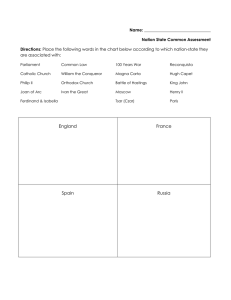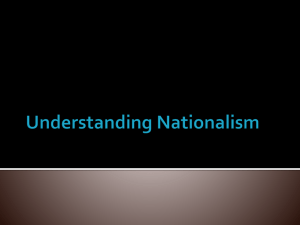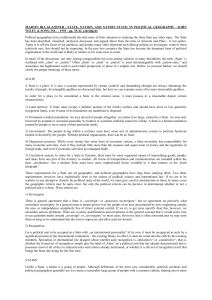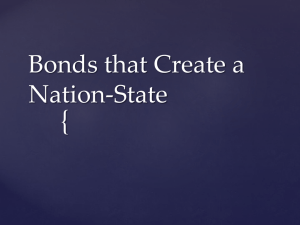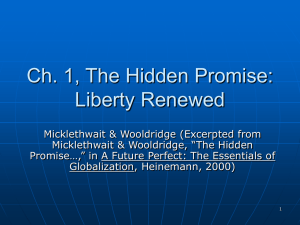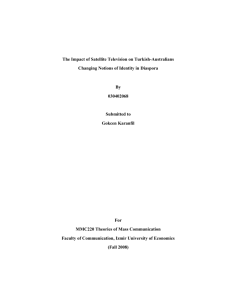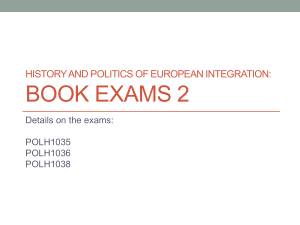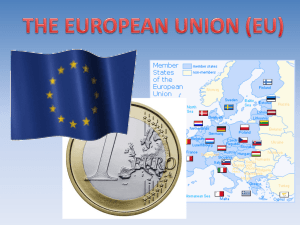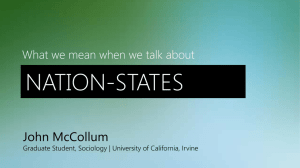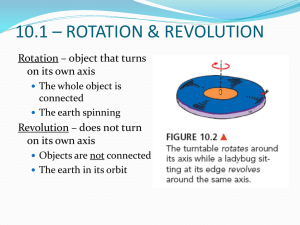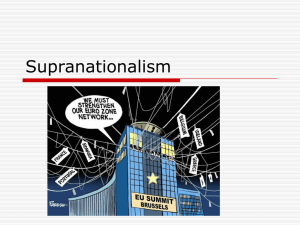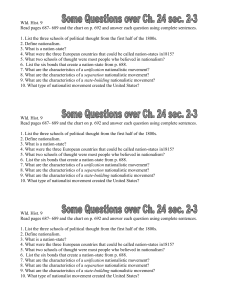4.1 - Sample Unit Plan.doc
advertisement
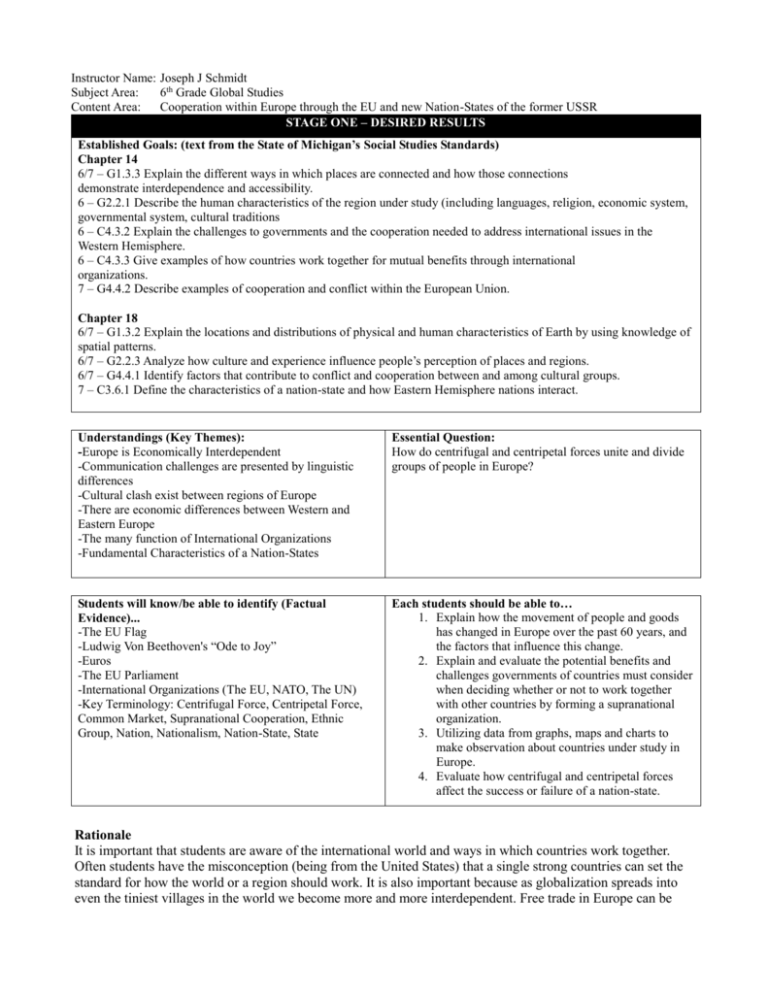
Instructor Name: Joseph J Schmidt Subject Area: 6th Grade Global Studies Content Area: Cooperation within Europe through the EU and new Nation-States of the former USSR STAGE ONE – DESIRED RESULTS Established Goals: (text from the State of Michigan’s Social Studies Standards) Chapter 14 6/7 – G1.3.3 Explain the different ways in which places are connected and how those connections demonstrate interdependence and accessibility. 6 – G2.2.1 Describe the human characteristics of the region under study (including languages, religion, economic system, governmental system, cultural traditions 6 – C4.3.2 Explain the challenges to governments and the cooperation needed to address international issues in the Western Hemisphere. 6 – C4.3.3 Give examples of how countries work together for mutual benefits through international organizations. 7 – G4.4.2 Describe examples of cooperation and conflict within the European Union. Chapter 18 6/7 – G1.3.2 Explain the locations and distributions of physical and human characteristics of Earth by using knowledge of spatial patterns. 6/7 – G2.2.3 Analyze how culture and experience influence people’s perception of places and regions. 6/7 – G4.4.1 Identify factors that contribute to conflict and cooperation between and among cultural groups. 7 – C3.6.1 Define the characteristics of a nation-state and how Eastern Hemisphere nations interact. Understandings (Key Themes): -Europe is Economically Interdependent -Communication challenges are presented by linguistic differences -Cultural clash exist between regions of Europe -There are economic differences between Western and Eastern Europe -The many function of International Organizations -Fundamental Characteristics of a Nation-States Essential Question: How do centrifugal and centripetal forces unite and divide groups of people in Europe? Students will know/be able to identify (Factual Evidence)... -The EU Flag -Ludwig Von Beethoven's “Ode to Joy” -Euros -The EU Parliament -International Organizations (The EU, NATO, The UN) -Key Terminology: Centrifugal Force, Centripetal Force, Common Market, Supranational Cooperation, Ethnic Group, Nation, Nationalism, Nation-State, State Each students should be able to… 1. Explain how the movement of people and goods has changed in Europe over the past 60 years, and the factors that influence this change. 2. Explain and evaluate the potential benefits and challenges governments of countries must consider when deciding whether or not to work together with other countries by forming a supranational organization. 3. Utilizing data from graphs, maps and charts to make observation about countries under study in Europe. 4. Evaluate how centrifugal and centripetal forces affect the success or failure of a nation-state. Rationale It is important that students are aware of the international world and ways in which countries work together. Often students have the misconception (being from the United States) that a single strong countries can set the standard for how the world or a region should work. It is also important because as globalization spreads into even the tiniest villages in the world we become more and more interdependent. Free trade in Europe can be equated to free trade in North America, and broadly to free trade anywhere. The Euro itself is a compelling topic, as it becomes more powerful than the dollar, and thus begs the question of how long US domination can last. Similarly as we transition from learning about the EU to learning about the successes and failures of former Soviet states we can begin to work through the kinds of forces that ultimately decide whether or not a country will be successful. Students have a naïve perception of the world and its countries as being something concrete and permanent. STAGE TWO – ASSESSMENT EVIDENCE Performance Tasks -Act-Out simulation of life before and during the EU. -EU parliament simulation. -Graphing practice worksheet. -Mid-Unit Pretest -Unit Review Guide -Jeopardy Responses -Unit Test (Confederated States) Other Evidence -Student contributions during discussions/debates (use of the EU, cultural additions presentations, NationState fishbowls) -Student Interactive Notebook / Packet sectional worksheets. -Picking Stickies Questions STAGE THREE - OVERVIEW Daily Learning Activities Monday, March 1st -Simulation of travel around Europe BEFORE the EU. (Experiences include language, monetary, and passport differences) -Reading of opening sections and investigate new terms with partners (Centrifugal Force, Centripetal Force, Common Market, Supranational Cooperation) Tuesday, March 2nd -Group reading about the formation and application of the Euro. (Making connections) -Class simulation of travel around Europe DURING the EU. (Experiences include common passports and MOST countries sharing the Euro. Some countries won't (the UK because they choose to keep their own money, and Poland because they were prohibited) which will bring unique challenges to people from those countries, or people who want to visit those countries. Wednesday, March 3rd -Individual reading about political reasons for cooperation, and the main governing bodies of the EU. (Formulate text based questions) -Simulation of decision making within the EU parliament. (Seated in Country blocks. Countries make proposals,) -With partner, complete “Graphing Practice” analyzing a cartogram of representation within the EU parliament. Thursday, March 4th -Class reading about cultural differences between countries, and the actions taken by the EU government to attempt to unite different people. (View EU Flag, Listen to “Ode to Joy.”) -Each country block independently learns about their own culture, and then shares out to the class about their culture. -Discussion of cultural diffusion, and where we have learned about it before (globalization unit). Monday, March 8th -Work in groups of three on the final two sections while completing their “Scramble” (connections, map analysis). -Watch EU Video (Things to note: Many Countries flags, but also EU flag, Ludwig Von Beethoven “Ode to Joy” as EU anthem). -Mid-Unit Pretest using clickers and self reporting worksheet (Students who struggle are identified and pulled in for additional help). Tuesday, March 9th -Analyze photographs of Lubyanka Square in Moscow before and after people tore down a statue of Iron Felix. -Roundtable fishbowl talking about reasons why people might reject their government. -Partners read opening sections and investigate new terms (Ethnic Group, Nation, Nationalism, Nation-State, State). Wednesday. March 10th -Presentations of self-generated posters explaining assigned term (use of Frayer Model: Definition, Unique Sentence, Examples, Non-Examples). -Introduction to format of the packet to be used for the remained of the Unit. -Partners read about their first Nation-State case study: Kazakhstan. After reading they work with partners to complete nation-state page. -Answers modeled. Thursday, March 11th -Class review of packet format. -Work with partners to read about two additional case studies of Nation-States: Azerbaijan and Belarus. When complete with first case study, receive a class set of answers to check answers. Then they repeat the process for the second case study. -Students form two groups: People who believe the nation-state will stay together, and those who think it will not. Six people debate the issue in a fishbowl. Friday, March 12th -Class review of packet format. -Work with partners to read about two additional case studies of Nation-States: Lithuania and Russia. When complete with first case study, receive a class set of answers to check answers. Then they repeat the process for the second case study. -Students form two groups: People who believe the nation-state will stay together, and those who think it will not. Six people debate the issue in a fishbowl. Monday, March 15th -Work on the final two sections in pairs while completing their “Scramble.” (What do we know for sure about nationstates?) -As a class, analyze a graph of world wide independence, color coded to show when countries gained their independence. Then compare that map to one of Developed countries and discuss any possible correlations and the significance of any correlations. (All developed nations with the exception of Germany gained their independence before 1945; hence it is too early to judge the new Nation-States that evolved from the former USSR.) -Complete Unit Review Sheet with partners. When/if students finish, they create their own Unit Questions with Picking Stickies activity, and quiz each other. Tuesday, March 16th -First half of their Unit Test: Objective 4. The format requires analysis of text, understanding of key terminology (Centrifugal forces, Centripetal Forces, Nation-States) and critical thinking. (Confederated States) -Remainder of time spent playing European Jeopardy with questions and answers generated from previous days Picking Stickies activity. Wednesday, March 17th -Take the other half of their Unit Test: Objectives 1, 2, and 3. The format of the test is a mix of multiple choice and short answer responses). -Any remaining time should be spent reading a choice book or completing other class work.
